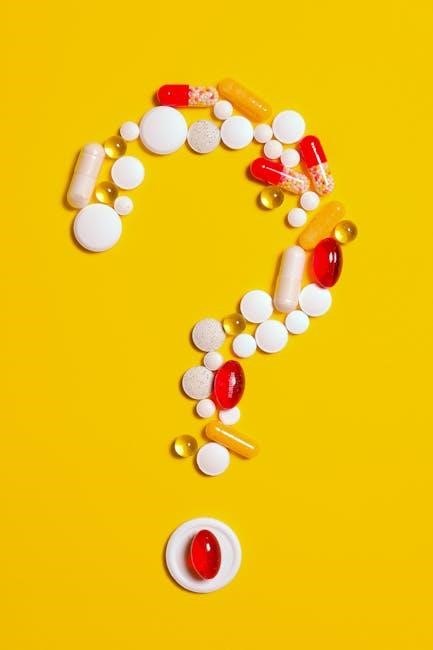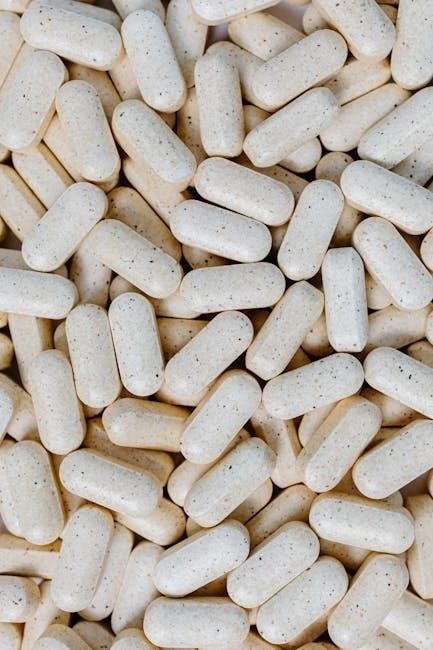
pharmaceutical calculations questions and answers pdf
Pharmaceutical calculations are essential for accurate drug dosing and preparation. Resources like PDF guides provide practice questions and answers, covering dosage, dilutions, and pharmacokinetics, aiding skill development.
Importance of Pharmaceutical Calculations in Pharmacy Practice
Pharmaceutical calculations are critical for ensuring patient safety and accurate drug therapy. They enable pharmacists to determine correct dosages, prepare compounded medications, and manage inventory effectively. Accurate calculations prevent errors, which can lead to adverse drug reactions or therapeutic failures. These skills are essential for interpreting prescriptions, labeling products, and providing proper patient counseling. Additionally, pharmaceutical calculations are vital in clinical settings for intravenous (IV) preparations, pediatric dosing, and oncology treatments, where precision is paramount. Practicing with questions and answers from resources like PDF guides helps pharmacists refine their skills, ensuring competence in real-world scenarios. Mastery of these calculations enhances professionalism, improves patient outcomes, and maintains trust in pharmacy services.
Common Types of Pharmaceutical Calculations
Pharmaceutical calculations encompass several key types, including dosage calculations for oral and parenteral medications, dilution problems, and unit conversions. Dosage calculations ensure correct medication administration, while dilution problems involve preparing solutions to specific concentrations. Unit conversions are fundamental for interpreting drug strengths and prescriptions. Pharmacists also perform calculations for pediatric dosing, compounding, and pharmacokinetics, such as half-life and clearance. These calculations are critical for accuracy and safety in pharmacy practice, requiring a strong understanding of formulas and methods. Practice questions and answers in PDF resources help professionals master these skills, covering a range of scenarios and ensuring proficiency in real-world applications.

Overview of Pharmaceutical Calculations Questions and Answers PDF
Pharmaceutical Calculations Questions and Answers PDFs are comprehensive resources designed to assist students and professionals in mastering essential mathematical skills. These documents typically include a wide range of practice questions, covering topics such as dosage calculations, dilutions, unit conversions, and pharmacokinetics. Many PDFs feature multiple-choice questions (MCQs) with detailed solutions, allowing users to assess their understanding and improve problem-solving abilities. They often align with popular textbooks, providing additional practice for exam preparation. Some resources also include case studies and real-world scenarios to enhance practical application. Answer keys and step-by-step explanations are commonly provided, ensuring learners can identify and correct mistakes. These PDFs are invaluable tools for anyone seeking to excel in pharmaceutical calculations, offering a structured approach to skill development and exam readiness.

Fundamental Concepts in Pharmaceutical Calculations
Mastering measurement systems, density, and unit conversions is crucial. PDF resources provide practice questions and answers, ensuring proficiency in these foundational areas for accurate drug preparation and administration.
Measurement Systems and Units in Pharmacy
Understanding measurement systems and units is vital in pharmacy practice. Common units include grams, milligrams, liters, and milliliters. Conversions between these units are frequently required in pharmaceutical calculations. PDF resources offer practice questions and answers, such as converting milligrams to grams and milliliters to liters, which are essential skills for pharmacists. These exercises help in developing accuracy and consistency, preventing errors in drug dosing and preparation. For instance, converting 500 milligrams to grams involves dividing by 1000, resulting in 0.5 grams. Similarly, 250 milliliters is equivalent to 0.25 liters. Such conversions are fundamental and are regularly assessed in multiple-choice questions and practice exams. The ability to perform these calculations efficiently ensures patient safety and effective medication management.
Density and Specific Gravity Calculations
Density and specific gravity are critical in pharmacy for formulation and compounding. Density is mass per unit volume, typically expressed in g/mL or kg/L. Specific gravity compares a substance’s density to water’s. PDF guides provide questions and answers on these topics, aiding pharmacists in calculating concentrations and mixing solutions accurately. For example, determining the mass of a liquid using its density helps in preparing accurate formulations. Practice problems often involve converting units and applying formulas, ensuring precision in drug delivery systems; These calculations are essential for maintaining product quality and safety, and are frequently tested in exams to ensure competency.
Conversions Between Units (e.g., mg to g, mL to L)
Unit conversions are fundamental in pharmacy practice, ensuring accurate drug dosing and preparation. Common conversions include milligrams to grams (mg to g) and milliliters to liters (mL to L). For instance, 1 gram equals 1000 milligrams, and 1 liter equals 1000 milliliters. Pharmaceutical calculations questions and answers PDFs often provide practice problems to master these conversions. Accurate unit conversion is vital to prevent errors in medication administration. Resources include step-by-step guides and multiple-choice questions to assess understanding. These exercises help pharmacists and students apply conversions in real-world scenarios, such as calculating drug concentrations or infusion rates. Proficiency in unit conversions is essential for patient safety and effective pharmacy operations.

Dosage Calculations
Dosage calculations ensure accurate medication administration, covering oral and parenteral routes. Practice questions in PDFs provide scenarios for tablets, capsules, IV, and IM dosing, enhancing problem-solving skills.
Oral Dosage Calculations (e.g., Tablets, Capsules)
Oral dosage calculations involve determining the correct number of tablets or capsules for a patient’s dose. Common scenarios include converting milligrams to grams and calculating daily doses based on prescription instructions. For example, if a patient is prescribed 2 tablets of a medication containing 250 mg per tablet, the total dose would be 500 mg. Practice questions in PDF resources often provide real-world problems, such as calculating the number of tablets needed for a specific dose or adjusting doses based on patient weight. These exercises help pharmacists and students master essential skills in medication administration, ensuring accuracy and patient safety.
Parenteral Dosage Calculations (e.g., IV, IM)
Parenteral dosage calculations are critical for administering drugs via IV or IM routes. These calculations often involve converting doses to milliliters, calculating infusion rates, and ensuring accurate delivery. For instance, determining the flow rate for an IV drip requires knowing the total volume, desired time, and drop factor. Practice questions in PDF resources frequently address scenarios like calculating the mL/h for a patient receiving 1,000 mL of saline over 8 hours. Additional examples include determining the volume of a drug solution for IM injection or adjusting doses based on patient weight (e.g., micrograms/kg). These exercises help healthcare professionals master complex calculations, ensuring precise and safe drug administration in clinical settings. Accurate parenteral calculations are vital for patient care and preventing medication errors.
Case Studies in Dosage Calculations
Case studies in dosage calculations provide real-world scenarios to apply mathematical skills. They often involve complex situations, such as pediatric dosing, geriatric adjustments, or renal impairment. For example, calculating the correct dose for an infant requires adjusting for weight and age. Practice questions in PDF resources frequently include such challenges, along with detailed solutions. These case studies enhance problem-solving abilities by simulating clinical environments. Topics may include IV rate calculations, dose adjustments based on renal function, or converting between oral and parenteral routes. Case studies also emphasize patient-specific factors like allergies or drug interactions. Regular practice with these scenarios ensures pharmacists and healthcare professionals can handle diverse dosing challenges accurately and confidently, reducing medication errors in real-world practice.

Dilution and Concentration Problems

Dilution and concentration problems involve calculating stock solutions, serial dilutions, and final concentrations. Practice questions and answers in PDF resources cover methods like W/V, W/W, and V/V conversions.
Methods of Dilution (e.g., Serial Dilution, Stock Solutions)
Understanding methods of dilution is critical in pharmaceutical calculations. Serial dilution involves creating a series of progressively diluted solutions, often used in microbiology to determine concentrations. Stock solutions are concentrated liquids used as starting points for further dilutions. Common dilution methods include weight-to-volume (W/V), weight-to-weight (W/W), and volume-to-volume (V/V) calculations. Practice questions and answers in PDF resources provide step-by-step guidance on these techniques. For example, determining how many milliliters of water to add to a solution to achieve a specific concentration is a common problem. These exercises help pharmacists and students master accurate dilution practices, ensuring precise drug formulations and safe dosing. Regular practice with these problems enhances proficiency in handling real-world scenarios involving concentration adjustments.
Concentration Calculations (e.g., W/V, W/W, V/V)
Concentration calculations are fundamental in pharmacy practice, ensuring precise preparation of formulations. Weight-to-volume (W/V), weight-to-weight (W/W), and volume-to-volume (V/V) calculations are commonly used. W/V measures solute mass per solution volume, while W/W measures solute mass per total mass. V/V calculates the volume of solute in the total solution volume. Practice questions in PDF resources provide exercises like determining how many milliliters of water to add to a solution to achieve a specific concentration. These problems often involve converting percentages to decimal form and applying formulas. For example, preparing a 5% W/V solution requires calculating the grams of solute needed per 100 mL of solution. Regular practice with these calculations enhances accuracy in compounding and ensures safe drug dosing.
Practice Problems and Answers for Dilution Calculations
Dilution calculations are critical in pharmacy practice, ensuring accurate preparation of solutions. Practice problems in PDF resources cover serial dilutions, stock solutions, and concentration adjustments. For instance, questions ask how many milliliters of water to add to a 5% W/V solution to achieve a specific dilution. These problems often involve using formulas like ( C_1V_1 = C_2V_2 ) to maintain the solute amount during dilution. Examples include calculating the volume of a 10% solution needed to prepare 500 mL of a 2% solution. Detailed answers guide learners through step-by-step solutions, emphasizing unit conversions and practical applications. Regular practice with these problems enhances understanding of dilution principles and ensures precision in compounding, which is vital for patient safety and effective therapy.

Pharmacokinetic Calculations
Pharmacokinetic calculations involve understanding drug absorption, distribution, metabolism, and excretion. PDF resources provide multiple-choice questions on half-life, clearance, and bioavailability, aiding in mastering these critical concepts effectively.
Half-Life and Drug Elimination
Understanding half-life and drug elimination is crucial in pharmacokinetics. The half-life determines how quickly a drug is removed from the body, influencing dosing intervals and steady-state concentrations. PDF resources provide multiple-choice questions and practice problems on calculating half-life, elimination rate constants, and time to reach steady state. These questions often involve scenarios where pharmacists must estimate how long it takes for a drug to be eliminated or how dosing schedules impact drug levels. For example, calculating the time required for 90% of a drug to be eliminated involves understanding its half-life. Practice exams and review problems in PDF guides offer detailed solutions, helping pharmacists master these calculations. These resources are invaluable for ensuring accurate drug dosing and minimizing adverse effects in clinical practice.
Clearance and Bioavailability Calculations
Clearance (CL) and bioavailability (F) are critical pharmacokinetic parameters. Clearance measures the volume of plasma cleared of a drug per unit time, while bioavailability reflects the fraction of a drug reaching systemic circulation. These calculations are essential for determining dosing regimens and drug efficacy. PDF resources provide practice questions and detailed answers on calculating CL using the formula ( CL = rac{Dose}{AUC} ) and estimating bioavailability through methods like ( F = rac{AUC_{oral}}{AUC_{IV}} ). Common problems involve adjusting doses based on bioavailability and calculating clearance in patients with renal or hepatic impairment. Multiple-choice questions and case studies in these PDF guides help pharmacists understand how these parameters influence drug therapy and optimize patient outcomes. Mastering these calculations ensures precise dosing and minimizes toxicity or therapeutic failure in clinical practice.
Multiple Choice Questions on Pharmacokinetics
Multiple-choice questions (MCQs) on pharmacokinetics are a valuable tool for assessing understanding of drug absorption, distribution, metabolism, and excretion (ADME). PDF resources provide comprehensive question banks covering key concepts like half-life, clearance, and bioavailability. These questions often present clinical scenarios, requiring calculation of doses, volumes of distribution, or steady-state concentrations. Detailed answers and explanations are included to aid learning. Topics include interpreting plasma concentration-time profiles, understanding first-order vs. zero-order kinetics, and calculating drug dosing intervals. MCQs also address practical applications, such as adjusting doses for renal impairment or calculating loading doses. Regular practice with these questions enhances problem-solving skills and prepares pharmacists for real-world clinical challenges, ensuring accurate and effective patient care.

Practical Examples and Case Studies
Pharmaceutical calculations questions and answers PDFs offer real-world case studies, covering scenarios like pediatric dosing, IV infusions, and concentration adjustments. These examples, supported by detailed solutions, enhance practical application skills.
Common Prescription Scenarios and Solutions
Pharmaceutical calculations questions and answers PDFs often include real-life prescription scenarios, such as determining dosages for pediatric patients or adjusting concentrations for IV solutions. These examples provide step-by-step solutions to common challenges, like converting units or calculating infusion rates. For instance, a scenario might involve prescribing tablets for an adult or adjusting the volume of a suspension for an infant. The answers guide through estimation, unit conversion, and final calculation methods, ensuring accuracy and safety. These practical problems help pharmacists and students master essential skills, such as handling fractional doses or preparing solutions from stock concentrations. The PDF resources also cover complex cases, like multiple-drug regimens or weight-based dosing, making them invaluable for both learning and professional practice.
Infant and Pediatric Dosing Calculations
Pharmaceutical calculations questions and answers PDFs emphasize infant and pediatric dosing, addressing unique challenges like weight-based dosing and liquid medication measurement. These resources provide step-by-step guides for calculating doses based on body weight and age, ensuring safe and effective treatment. For example, a question might involve determining the mL of a suspension for a child weighing 15 kg. Answers often include converting kilograms to grams or milligrams and applying pediatric-specific formulas. Practical examples cover scenarios like calculating microgram/kg doses for neonates or adjusting concentrations for oral syringes. These PDFs also address common errors, such as dosage miscalculations due to decimal point misplacement, and offer tips for accurate measurement using pediatric-friendly devices, making them crucial for pharmacists, nurses, and healthcare professionals working with children.
Practice Problems for Real-World Applications
Pharmaceutical calculations questions and answers PDFs offer realistic scenarios to bridge theory and practice. These problems simulate actual pharmacy situations, such as calculating IV drip rates or adjusting dosages for pediatric patients. For instance, a question might ask how many milliliters of a drug solution to administer to achieve a specific dose, requiring conversion between units like mcg to mg and mL to L. Answers provide detailed step-by-step solutions, highlighting common pitfalls and offering tips for accurate computations. Topics include oral and parenteral dosing, dilution techniques, and pharmacokinetic calculations, ensuring comprehensive preparation for real-world challenges. These practice problems are invaluable for students, interns, and professionals seeking to refine their calculation skills and apply them in clinical settings effectively.

Assessment and Practice Exams
Practice exams with pharmaceutical calculations questions and answers PDFs offer comprehensive assessment tools. They include multiple-choice questions, case studies, and detailed solutions to enhance exam preparation and problem-solving skills effectively.
Sample Practice Exams for Pharmaceutical Calculations
Sample practice exams for pharmaceutical calculations provide comprehensive assessment tools to evaluate understanding of dosage, dilution, and pharmacokinetic problems. These exams include multiple-choice questions, case studies, and calculation problems, mirroring real exam formats. They cover foundational topics such as unit conversions, density calculations, and oral/parenteral dosing, as well as advanced areas like bioavailability and half-life determinations. Detailed answer keys and explanations are often included, enabling users to identify areas for improvement. Many resources, such as PDF guides, offer practice exams with solutions, simulating exam conditions to help students and professionals gauge their readiness. Regular practice with these exams enhances problem-solving skills and builds confidence in handling complex pharmaceutical calculations effectively.
Review Problems with Detailed Answers
Review problems with detailed answers are crucial for mastering pharmaceutical calculations. These problems cover a wide range of topics, including dosage calculations, dilution methods, and pharmacokinetic equations. Each problem is accompanied by a step-by-step solution, allowing learners to understand the thought process and mathematical steps required. The detailed answers help identify common errors and improve accuracy. Many resources, such as PDF guides, offer these review problems to reinforce learning. By practicing these problems, students and professionals can enhance their problem-solving skills and gain confidence in handling complex calculations. The explanations provided in the answers are clear and concise, making them an invaluable tool for self-assessment and improvement in pharmaceutical calculations.
Case Studies in Problem-Solving
Case studies in pharmaceutical calculations provide real-world scenarios that challenge learners to apply theoretical knowledge to practical problems. These scenarios often involve complex dosing calculations, such as pediatric or geriatric dosing, and require consideration of patient-specific factors like weight, renal function, and drug interactions. For example, a case study might involve determining the appropriate dose of a medication for a child based on their body surface area or calculating the infusion rate for a critically ill patient. Detailed explanations guide learners through the problem-solving process, emphasizing critical thinking and attention to detail. These case studies help bridge the gap between classroom learning and clinical practice, ensuring that professionals are prepared to handle diverse and challenging situations effectively.

Resources and Further Learning
Textbooks like A Guidebook of Pharmaceutical Calculations and online resources offer comprehensive practice questions and answers, aiding in mastering dosage, dilution, and pharmacokinetic calculations for pharmacy professionals.
Recommended Textbooks for Pharmaceutical Calculations
Several textbooks are highly recommended for mastering pharmaceutical calculations. A Guidebook of Pharmaceutical Calculations by Howard C. Ansel is a popular choice, offering detailed explanations and practice problems. Another excellent resource is Pharmaceutical Calculations by Sohel C. Patel, which provides comprehensive coverage of dosage calculations, dilutions, and pharmacokinetics. These textbooks include numerous practice questions and answers, enabling students and professionals to refine their skills. Many of these books are accompanied by online resources or PDF guides, making them accessible for self-study. They also feature real-world case studies and step-by-step solutions, ensuring a thorough understanding of complex calculations. These textbooks are invaluable for anyone preparing for exams or seeking to improve their proficiency in pharmaceutical mathematics.
Online Resources for Practice Questions
Various online platforms offer comprehensive practice questions and answers for pharmaceutical calculations, available in PDF format. Websites like Docsity provide exam questions with correct answers, covering topics such as dosage calculations, dilutions, and pharmacokinetics. The Royal College of Nursing also offers resources, including guides like “Safety in Numbers,” which focus on numerical skills for healthcare professionals. Additionally, university portals and educational forums often share practice tests and review problems, complete with detailed solutions. These resources are ideal for self-assessment and exam preparation, ensuring proficiency in pharmaceutical mathematics. They are easily accessible and cover a wide range of calculation types, making them invaluable for students and practitioners alike. Utilizing these tools helps build confidence and accuracy in performing complex drug-related calculations.
Future Directions in Pharmaceutical Calculations
Advancements in technology and personalized medicine are reshaping pharmaceutical calculations. The integration of artificial intelligence and machine learning promises to enhance accuracy and efficiency in drug dosing and formulation. Future trends include the development of adaptive dosing regimens based on patient-specific factors, such as genetics and metabolic rates. Additionally, the rise of nanotechnology and targeted drug delivery systems requires sophisticated calculations to optimize therapeutic outcomes. Educational resources, including PDF guides, will play a critical role in training professionals to tackle these emerging challenges. As the field evolves, staying updated with the latest tools and methodologies will be essential for pharmacists and healthcare providers to deliver precise and effective patient care.
Leave a Reply
You must be logged in to post a comment.